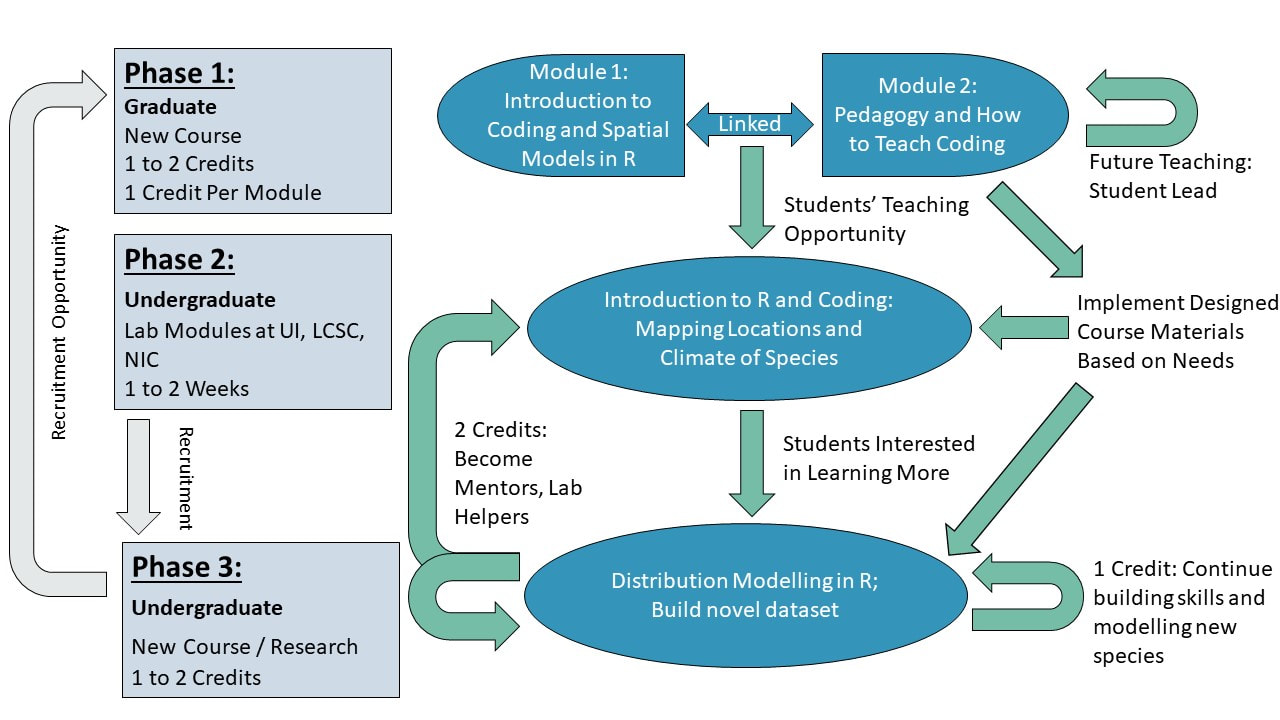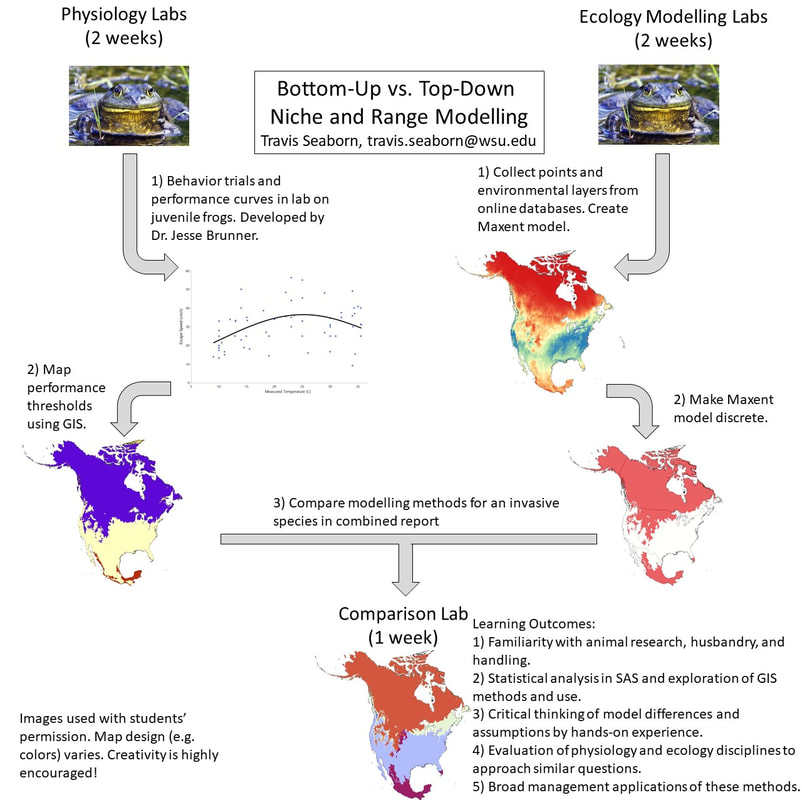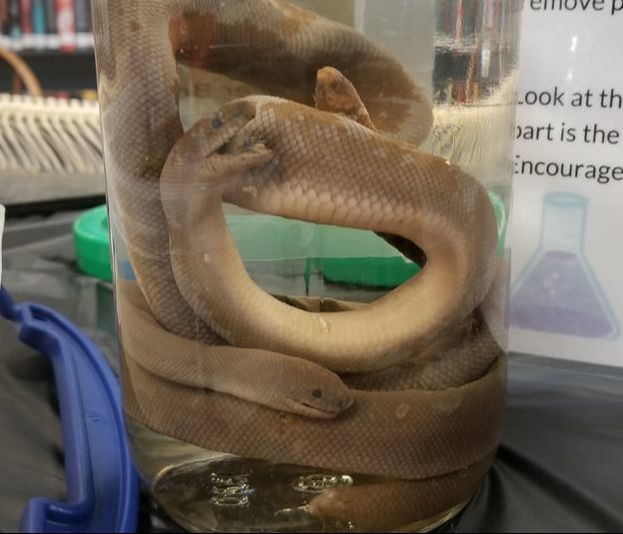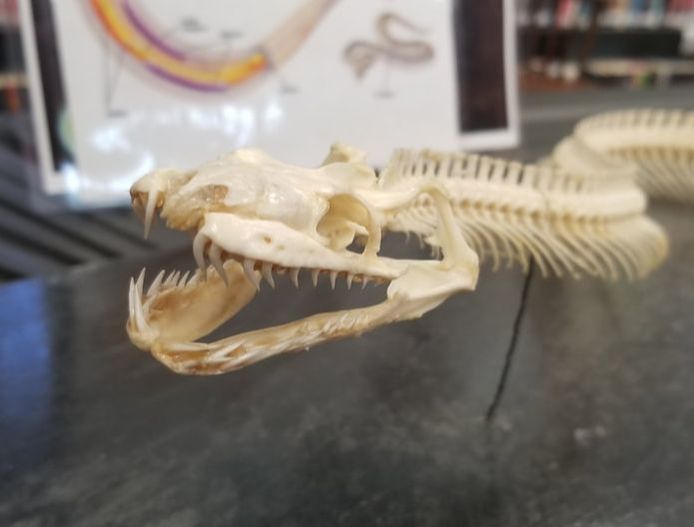Here you can find some info on Dr. Seaborn's teaching beliefs, philosophy, and some examples. Dr. Seaborn also created and is continuing to expand the software tutorial for CDMetaPOP, which can be found at the following website.
Teaching Philosophy Statement (Generic). Dr. Seaborn thoroughly love teaching, and hope that it continues to play a large part in his career both formally and informally.
|
Vertically Integrated Program (VIP)
Dr. Seaborn was awarded a small grant through EPSCoR / GEM3 to develop a VIP which integrates multiple new courses and Idaho education partners to provide graduate and undergraduate opportunities. The overall goal is to provide training in coding and tech pedagogy for graduate students, and integrating those skills to teach undergraduates about species distribution models and gene-environment relationships. |
Inquiry Based Experiential Learning Example: Research in the Classroom
Dr. Seaborn truly believes that you can conduct meaningful research within the classroom by adapting modern techniques and technology with the primary educational goals. Below he gives one example of how he thinks this can be done:
I've been fortunate enough to be a teaching assistant for someone who has given me the freedom to design and implement my own labs and guest lecture. Building from one of Dr. Jesse Brunner's original labs for the Biology of Amphibians and Reptiles course, I've spent time trying to help scale up they physiology experiments students were doing in the lab on an invasive species to the landscape level after completing a niche model for a herptile of their choice. Below you can find a cartoon of how this multiple week, multiple experiment, series of labs play out. Skill outcomes include and introduction GIS, integrating statistics from JMP, and Maxent models. Overall learning objectives primarily include critical thinking and communication by comparing and contrasting models, developing management recommendations in a written report, and understanding experimental scale. Assessment is focused on the final paper. Here are the PDFs. Please note that each year these are edited to better match the current versions of QGIS / Maxent. Part 1 and 2 ; Part 3. Please don't hesitate to contact me if you have questions.
Dr. Seaborn truly believes that you can conduct meaningful research within the classroom by adapting modern techniques and technology with the primary educational goals. Below he gives one example of how he thinks this can be done:
I've been fortunate enough to be a teaching assistant for someone who has given me the freedom to design and implement my own labs and guest lecture. Building from one of Dr. Jesse Brunner's original labs for the Biology of Amphibians and Reptiles course, I've spent time trying to help scale up they physiology experiments students were doing in the lab on an invasive species to the landscape level after completing a niche model for a herptile of their choice. Below you can find a cartoon of how this multiple week, multiple experiment, series of labs play out. Skill outcomes include and introduction GIS, integrating statistics from JMP, and Maxent models. Overall learning objectives primarily include critical thinking and communication by comparing and contrasting models, developing management recommendations in a written report, and understanding experimental scale. Assessment is focused on the final paper. Here are the PDFs. Please note that each year these are edited to better match the current versions of QGIS / Maxent. Part 1 and 2 ; Part 3. Please don't hesitate to contact me if you have questions.
Bullfrog photo credit: Wiki Commons
Building Foundational Knowledge: Anatomy and Local Herptiles
Dr. Seaborn truly believe that you can conduct meaningful research within the classroom by adapting modern techniques and technology with the primary educational goals. Below he gives one example of how this can be done.
Serving as the first lab, students label the anatomy of the overall amphibian and reptile forms and vocabulary. They are then presented with a list of vocabulary terms they must sketch and define. These terms serve to get students familiar with their field guide (Stebbins). Last, they are then expected to find a preserved specimen that each term applies to (e.g. autotomy is shown in one of our western skinks). This lab was written to increase the sophistication and ability to do the following lab, which is constructing dichotomous keys of the preserved species. Skill outcomes include use of a field guide, sketching and recording observations, and a foundational knowledge of local wildlife and their anatomy to build upon throughout the course. Learning objectives include the ability to collect information, and then critical thinking with applying this information to a new scenario/set of species. Assessment occurs by turning in the final hand out and the incorporation of the vocabulary in the future, including exam questions. This lab can be found here.
Dr. Seaborn truly believe that you can conduct meaningful research within the classroom by adapting modern techniques and technology with the primary educational goals. Below he gives one example of how this can be done.
Serving as the first lab, students label the anatomy of the overall amphibian and reptile forms and vocabulary. They are then presented with a list of vocabulary terms they must sketch and define. These terms serve to get students familiar with their field guide (Stebbins). Last, they are then expected to find a preserved specimen that each term applies to (e.g. autotomy is shown in one of our western skinks). This lab was written to increase the sophistication and ability to do the following lab, which is constructing dichotomous keys of the preserved species. Skill outcomes include use of a field guide, sketching and recording observations, and a foundational knowledge of local wildlife and their anatomy to build upon throughout the course. Learning objectives include the ability to collect information, and then critical thinking with applying this information to a new scenario/set of species. Assessment occurs by turning in the final hand out and the incorporation of the vocabulary in the future, including exam questions. This lab can be found here.



